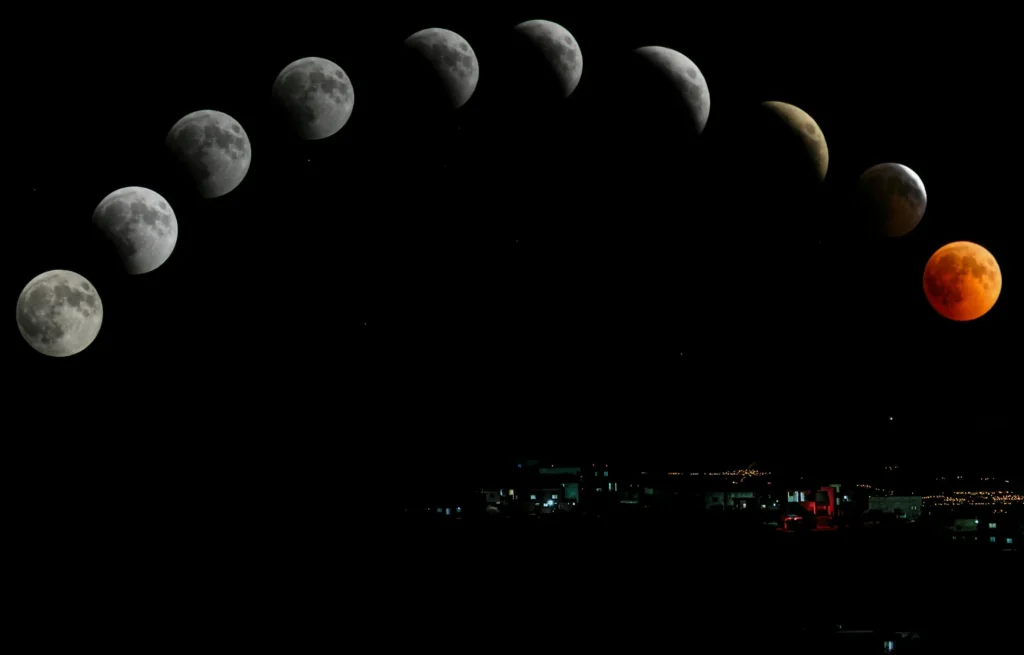Mark your calendars for March 14, 2025, as the night sky is set to dazzle with a total lunar eclipse, often referred to as a “Blood Moon.” This celestial event offers a unique opportunity to witness the Moon bathed in a reddish hue, captivating skywatchers worldwide. To ensure you make the most of this experience, here’s everything you need to know, from timings to safety tips.
Table of Contents
1. Understanding the Lunar Eclipse and Its Significance
A total lunar eclipse occurs when the Earth aligns directly between the Sun and the Moon, casting Earth’s shadow over the Moon and giving it a characteristic reddish tint, hence the term “Blood Moon.” This phenomenon not only provides a visual treat but also holds cultural and astrological significance. For instance, astrologers believe that such eclipses can influence various aspects of life, prompting introspection and change.
2. Timings and Visibility: When and Where to Watch
The total lunar eclipse on March 14, 2025, will be visible across various parts of the world. Here’s a breakdown of the key phases:
- Penumbral Eclipse Begins: 03:57 UTC
- Partial Eclipse Begins: 05:09 UTC
- Total Eclipse Begins: 06:25 UTC
- Maximum Eclipse: 06:58 UTC
- Total Eclipse Ends: 07:32 UTC
- Partial Eclipse Ends: 08:48 UTC
- Penumbral Eclipse Ends: 10:00 UTC
For observers in Jaipur, India, the eclipse will not be visible, as it occurs during daylight hours.
However, enthusiasts can still participate by watching live streams provided by various astronomical organizations.
3. Safety Precautions for March 2025 lunar eclipse
Unlike solar eclipses, viewing a lunar eclipse is safe for the eyes, and no special equipment is necessary. However, to enhance your experience:
- Use Binoculars or Telescopes: These tools can provide a closer look at the Moon’s surface and the subtle changes during the eclipse.
- Choose a Dark Viewing Location: Find an area with minimal light pollution to fully appreciate the eclipse’s beauty.
4. Cultural Considerations: Traditions and Beliefs
In various cultures, lunar eclipses are accompanied by specific traditions and beliefs:
- Dietary Practices: Some traditions advise against eating during the eclipse, suggesting potential negative effects on food or digestion. Scientifically, there’s no evidence to support this, but individuals may choose to follow such practices for cultural or religious reasons.
- Pregnancy Precautions: Certain cultures recommend that pregnant women stay indoors during an eclipse to protect the unborn child. While there’s no scientific basis for this, respecting cultural sentiments is essential.
5. Capturing the Moment: Photography Tips
If you’re keen on photographing the eclipse:
- Use a Tripod: To avoid blurry images, stabilize your camera.
- Adjust Exposure Settings: Lunar eclipses are dimmer than regular full moons, so longer exposure times may be necessary.
- Practice Prior: Familiarize yourself with your equipment before the event to ensure optimal shots.
Interactive Element: Eclipse Viewing Checklist
- Confirm the date and time of the eclipse in your location.
- Choose a suitable viewing spot with a clear horizon.
- Gather necessary equipment: binoculars, camera, tripod.
- Check weather forecasts to ensure clear skies.
- Plan for safety and comfort: appropriate clothing, seating, snacks.
Humor Corner: Eclipse Myths Busted
Ever heard that eating during an eclipse can turn you into a werewolf? Or that howling at the “Blood Moon” can improve your singing skills? While these myths are amusing, rest assured, enjoying a snack under the eclipsed moonlight is perfectly safe (and won’t enhance your vocal cords).
Conclusion: Embracing the Celestial Dance
Lunar eclipses are a reminder of the intricate choreography of our solar system. Whether you’re observing the event directly or tuning into a live stream, take a moment to appreciate the wonders of the universe and the shared experience that such celestial events offer. Are you waiting for March 2025 lunar eclipse? Let me know in the comments!
Note: The information provided is based on current astronomical data and cultural practices. Always consider local guidelines and personal comfort when planning to observe celestial events.
Next Read -> 2025 NFL Mock Draft: 7 Jaw-Dropping Predictions That Will Blow Your Mind!

